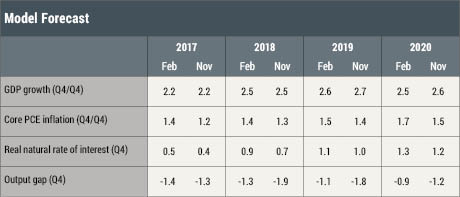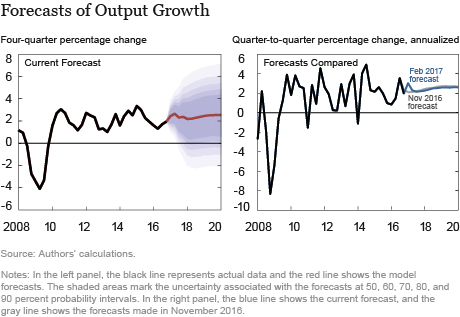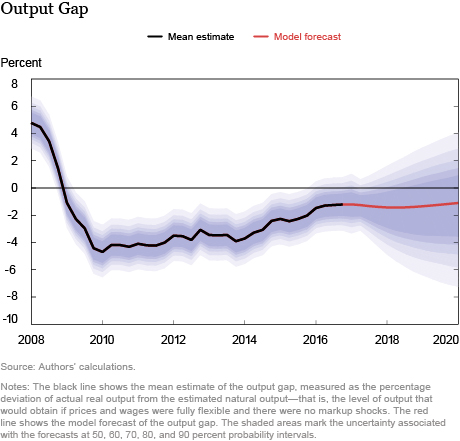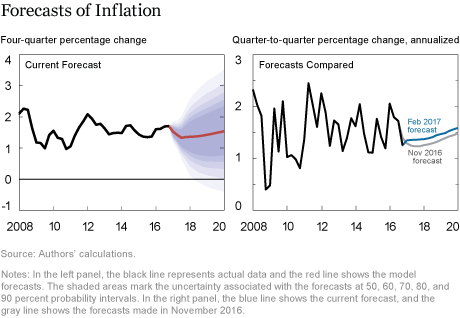This post presents the latest update of the economic forecasts generated by the Federal Reserve Bank of New York’s (FRBNY) dynamic stochastic general equilibrium (DSGE) model. We introduced this model in a series of blog posts in September 2014 and published forecasts twice a year thereafter. With this post, we move to a quarterly release schedule, and highlight how our forecasts have changed since November 2016.
Readers should keep in mind that the DSGE model forecast is not an official New York Fed forecast, but only an input to the Research staff’s overall forecasting process. For more information about the model and the variables discussed here, see our DSGE Model Q & A.
The table and charts below show the February model forecasts for 2017-20 alongside the forecasts produced in November 2016. The February projections use quarterly macroeconomic data released through the fourth quarter of 2016 and available financial data through the first quarter of 2017 (as of January 30, 2017).

How do the latest forecasts compare with the November forecasts?
- The current GDP growth forecast is somewhat stronger than its November counterpart in the short run (as one can see from the quarter-to-quarter comparison in the right panel of the chart below), mainly because the financial market spread between Baa corporate and Treasury securities narrowed since the elections. Nevertheless, the growth forecast is roughly unchanged on a year-over-year basis for 2017, as well as in the medium and longer run.
- The current forecast for core PCE (personal consumption expenditures) inflation is slightly higher than in November in spite of the low core inflation numbers for the fourth quarter of 2016, as wages are expected to grow at a firmer pace than in November and the output gap is projected to narrow at a somewhat faster pace. The modal forecast for core PCE inflation remains below the 2 percent Federal Open Market Committee long-run inflation objective.
- The uncertainty around the output growth and inflation forecasts is substantial, as the shaded areas in the charts make clear.

One reason for the moderate inflation forecast is that the level of real output is still forecast to remain below its potential over the next few years, as seen in the chart below. The uncertainty around the output gap forecasts is, however, very large.

The last variable we forecast is the real natural rate of interest—the real interest rate that would prevail in the economy were there no nominal rigidities or markup shocks (see the chart below). This variable can be understood as an estimate of where the real interest rate would be in the absence of monetary policy: that is, it summarizes the contribution that economic factors other than monetary policy make to interest rates.

The estimate of the real natural rate of interest has increased significantly since 2014, reflecting improving economic conditions, and its forecast has been revised up slightly since November. Going forward, the natural rate of interest is projected to continue to increase, albeit at a slower pace.
Disclaimer
The views expressed in this post are those of the authors and do not necessarily reflect the position of the Federal Reserve Bank of New York or the Federal Reserve System. Any errors or omissions are the responsibility of the authors.

Marco Del Negro is a vice president in the Federal Reserve Bank of New York’s Research and Statistics Group.

Marc Giannoni is an assistant vice president in the Group.
 Abhi Gupta is a senior research analyst in the Group.
Abhi Gupta is a senior research analyst in the Group.
 Pearl Li is a senior research analyst in the Group.
Pearl Li is a senior research analyst in the Group.

Erica Moszkowski is a senior research analyst in the Group.
How to cite this blog post:
Marco del Negro, Marc Giannoni, Abhi Gupta, Pearl Li, and Erica Moszkowski, “The FRBNY DSGE Model Forecast—February 2017,” Federal Reserve Bank of New York Liberty Street Economics (blog), February 17, 2017, http://libertystreeteconomics.newyorkfed.org/2016/11/the-frbny-dsge-model-forecastfebruary-2017.











 RSS Feed
RSS Feed Follow Liberty Street Economics
Follow Liberty Street Economics